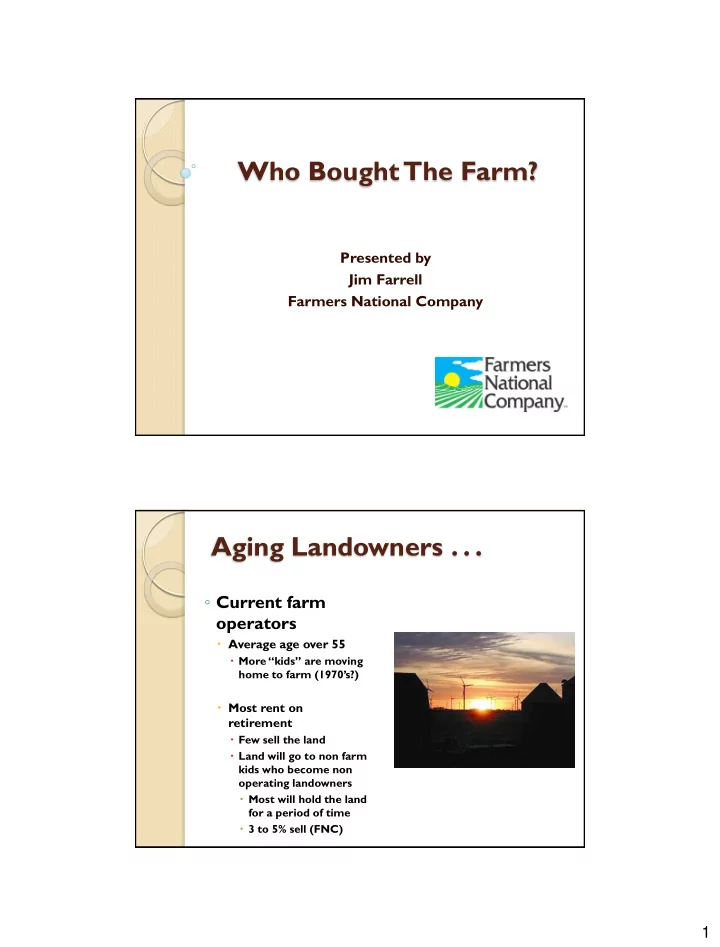

Who Bought The Farm? Presented by Jim Farrell Farmers National Company Aging Landowners . . . ◦ Current farm operators Average age over 55 More “kids” are moving home to farm (1970’s?) Most rent on retirement Few sell the land Land will go to non farm kids who become non operating landowners Most will hold the land for a period of time 3 to 5% sell (FNC) 1
The Silent Majority . . . Non operating owners ◦ 75% over age 65 (FNC survey) ◦ Pass land to heirs Some will gift the land Most cash rent This is the group who sell Own over 55% of the land + 95% of our sales The Land Market T oday The search for quality continues ◦ High quality farms and ranches still in high demand Returns have dropped by 35% to 40% Historically low cap rates from 3.25 to 4% ◦ Lesser quality farms are gaining some momentum Buyers are attracted to the better returns Prices are starting to increase on the lower quality units, but not as fast as they increased on the top land 2
Seller Reluctance Has Moderated Possible sellers remained tight holders of land throughout 2011 Poor alternative investments Bullish on ag FNC 2012 sales are up Currently we have sold 30% more units than a year ago Driven in part by tax concerns Also driven by market concerns Is this the top . . . ? More Buyers Than Sellers Strong demand from all sectors ◦ Several new funds are forming to buy land ◦ Money is pouring into this segment Limited to certain states ◦ The general public is aware of the positives of land 3
Who’s Buying T wo types of Investors 3. Farmers are in the market spending profits, and expanding ◦ 1. Those who currently own land and like the ◦ They are spending asset cash, but they are also Add on acres, generally low leveraging land they leverage already own ◦ 2. New investors Maybe 40% of sales have leverage Bullish on ag ◦ The margins are Will leverage narrowing Plan to hold for 10 years ◦ Very high operating Often little ag knowledge costs 3.5% to 3.75% returns More analytical The Dominate Buyer . . . ◦ So far in fiscal year 2012, we have sold over 600 farms and ranches - $420 million + Active farmers continue to dominate the buy side of the market, taking 70 to 75% of the sales They buy most of the auctioned properties New high prices are generally set by farmers at an auction A new phenomenon, the 80+ year old cash buyer! No return on CD’s or other safe investments Investors purchased between 25 and 30% of the properties Traditional investors buy approximately half More likely to bid/buy at auction than non traditional Non traditional new investors have been purchasing the other half 4
Current Buyers are Long-T erm Owners Farmers ◦ Own for a lifetime and beyond ◦ Using a lot of cash ◦ Average their cost over other land Investors are still basing purchases on return – 10 year window ◦ Very focused on the return ◦ Adjusted expectations downward to get something bought ◦ Some price resistance What Drives the Demand Excellent profits are the #1 driver ◦ Both farmers and investors are bullish long term on ag Renewable fuels Increasing world population More middle class consumers worldwide Increasing demand for more protein in diets ◦ Land was undervalued Investor perspective in 2005 – appreciation opportunity Interest Rates are #2 5
Some Changes Coming One Wall Street firm has decided to liquidate their land portfolio ◦ It was purchased in 2007 10 year ownership window ◦ They wanted better returns ◦ Land in 4 states ◦ 45,000 acres + Are We Focused on the Right Risks? 6
Is This a Bubble . . . “This time is different ” Balance sheets look positive Operating costs are sky rocketing ◦ What caused the crash in the 80’s Our support has political tentacles What would cause velocity? Is This Sustainable? If commodity prices remain strong Interest rates remain low ◦ A rate move that allows for a 4% or better CD rate is bearish If renewable fuel standards remain intact If the Chinese economy continues to grow 7
Thank You! 8
Recommend
More recommend